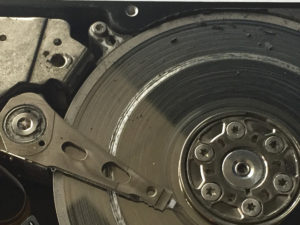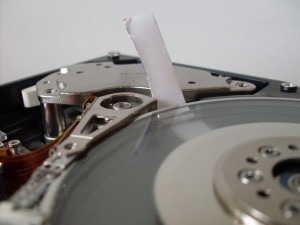
This hard drive shows rough platter damage where the head remained in contact with the platters for several hours of operation.
A grinding hard drive is a critical data emergency. This noise — which is distinct from the repetitive “click of death” — is the sound of an immediate and severe physical failure. The only safe action is to power it down immediately.
That grinding sound almost always means the read/write heads have crashed onto the platters (the magnetic discs that store your data). Every second the drive stays on, those heads are physically scraping away the magnetic material.
In this article, we’ll explain exactly what that noise means, the common mistakes that will make the problem worse, and the prognosis for recovery.
Datarecovery.com provides risk-free evaluations, and through our no data, no charge guarantee, you only pay for successful recovery attempts. To get started, submit a case online or call 1-800-237-4200 to speak with a data loss specialist.
What a Grinding Noise Means for Your Data

A hard drive with severely damaged platters.
Inside your hard disk drive (HDD), data is stored on rapidly spinning disks called platters. Tiny components called read/write heads float on a microscopic cushion of air just nanometers above those platters to read and write your data.
A head crash occurs when these heads lose that cushion of air and physically strike the platter surface. The grinding you hear is the sound of those heads literally digging into the platters, destroying the data tracks.
There’s a secondary concern here: A head crash also creates physical debris from the platter and head material, which then gets circulated by the spinning platters.
For hard drives, platter damage is the most common cause of permanent data loss: Once the data is physically scraped off the platters, there’s nothing that data recovery engineers can do. The good news is that modern drives are designed to prevent catastrophic head damage by landing the heads away from the platters — but if you’re hearing a grinding noise, there’s a good chance that those safeguards have failed.
Never Operate a Failing Hard Drive
If you hear an unusual noise coming from your hard drive’s chassis, turn the computer off.
Do not try to reboot. Do not try to see if it works one more time. Unplug the power cable from the computer or external enclosure.
Every moment of continued operation could potentially result in additional platter damage. Powering it down preserves whatever data is left (and this can be substantial, so the prognosis isn’t necessarily terrible for a full data recovery).
When facing data loss, panic can set in. Avoid the following:
- Do NOT run software to try to fix the problem. Utilities like CHKDSK (Check Disk) or other third-party recovery tools are designed for logical problems (like file deletion or formatting), not physical failure. Running software on a grinding drive only forces the heads to continue scraping away data. Learn more about why software can’t fix physical hard drive problems.
- Do NOT keep rebooting the drive. Each time you power the drive on, the heads must park and unpark, which moves them across the platters. If they’re in contact with the platters, that means permanent data loss
- Do NOT try the “freezer trick.” We’ve discussed this at length in other articles, but freezing your hard drive will not fix it. At best, nothing will change — at worst, you’ll cause additional damage.
- Do NOT open the drive enclosure. Physical hard drive failures must be addressed in a certified cleanroom. Opening the drive in a home or office environment can contaminate the platters and makes recovery far more difficult.
Data Recovery Solutions for Hard Drive Failures
A grinding sound indicates a severe physical hard drive failure, but sound alone isn’t enough for a diagnosis. We’ve encountered cases where HDDs made loud whirring and grinding sounds for hours without impacting the client’s data — and we’ve seen cases with major platter damage where hard drives didn’t show any noticeable physical symptoms.
The exact techniques we use for hard drive data recovery will vary depending on the extent of the failure, but all tickets follow this basic process:
- Cleanroom Diagnosis: The drive is first opened in a certified cleanroom to be assessed by an engineer. They will examine the platters under a microscope to determine the extent of the damage.
- Internal Repair: The failed head stack assembly (the part containing the read/write heads) must be replaced. This requires finding a compatible donor drive and performing a microscopic-level “transplant” inside the cleanroom.
- Specialized Imaging: After repairs, the drive can’t simply be plugged back into a computer. Instead, we connect it to purpose-built imaging hardware that can read around the damaged areas and clone the drive, sector by sector.
Datarecovery.com operates full-service laboratories with cleanroom technology at every location. We also maintain an expansive hardware inventory, which allows us to perform repairs quickly and safely — even on rare and obsolete hard drives.
If your hard drive is making grinding, clicking, or other unusual noises, trust the world leaders in HDD data recovery. Set up a risk-free evaluation online or call 1-800-237-4200 to get started.




